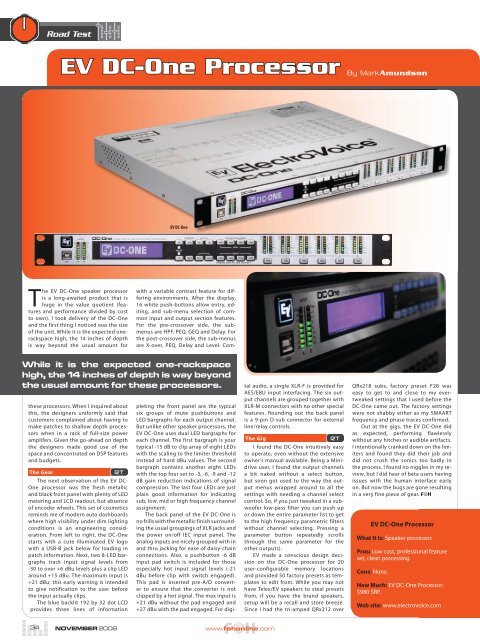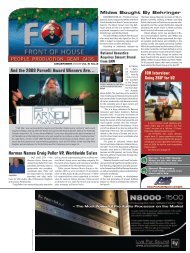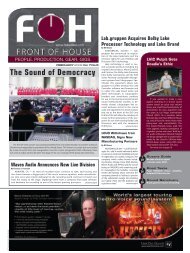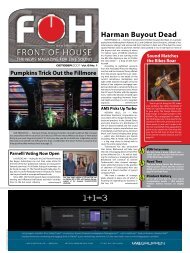You also want an ePaper? Increase the reach of your titles
YUMPU automatically turns print PDFs into web optimized ePapers that Google loves.
34<br />
Road Test<br />
EV DC-One Processor By MarkAmundson<br />
The EV DC-One speaker processor<br />
is a long-awaited product that is<br />
huge in the value quotient (features<br />
and performance divided by cost<br />
to own). I took delivery of the DC-One<br />
and the first thing I noticed was the size<br />
of the unit. While it is the expected onerackspace<br />
high, the 14 inches of depth<br />
is way beyond the usual amount for<br />
these processors. When I inquired about<br />
this, the designers uniformly said that<br />
customers complained about having to<br />
make patches to shallow depth processors<br />
when in a rack of full-size power<br />
amplifers. Given the go-ahead on depth<br />
the designers made good use of the<br />
space and concentrated on DSP features<br />
and budgets.<br />
The Gear RT<br />
The next observation of the EV DC-<br />
One processor was the fresh metallic<br />
and black front panel with plenty of LED<br />
metering and LCD readout, but absence<br />
of encoder wheels. This set of cosmetics<br />
reminds me of modern auto dashboards<br />
where high visibility under dim lighting<br />
conditions is an engineering consideration.<br />
From left to right, the DC-One<br />
starts with a cute illuminated EV logo<br />
with a USB-B jack below for loading in<br />
patch information. Next, two 8-LED bargraphs<br />
track input signal levels from<br />
-30 to over +6 dBu levels plus a clip LED<br />
around +15 dBu. The maximum input is<br />
+21 dBu; this early warning is intended<br />
to give notification to the user before<br />
the input actually clips.<br />
The blue backlit 192 by 32 dot LCD<br />
provides three lines of information<br />
EV DC-One<br />
with a variable contrast feature for differing<br />
environments. After the display,<br />
16 white push-buttons allow entry, editing,<br />
and sub-menu selection of common<br />
input and output section features.<br />
For the pre-crossover side, the submenus<br />
are HPF, PEQ, GEQ and Delay. For<br />
the post-crossover side, the sub-menus<br />
are X-over, PEQ, Delay and Level. Com-<br />
While it is the expected one-rackspace<br />
high, the 14 inches of depth is way beyond<br />
the usual amount for these processors.<br />
pleting the front panel are the typical<br />
six groups of mute pushbuttons and<br />
LED bargraphs for each output channel.<br />
But unlike other speaker processors, the<br />
EV DC-One uses dual LED bargraphs for<br />
each channel. The first bargraph is your<br />
typical -15 dB to clip array of eight LEDs<br />
with the scaling to the limiter threshold<br />
instead of hard dBu values. The second<br />
bargraph contains another eight LEDs<br />
with the top four set to -3, -6, -9 and -12<br />
dB gain reduction indications of signal<br />
compression. The last four LEDs are just<br />
plain good information for indicating<br />
sub, low, mid or high frequency channel<br />
assignment.<br />
The back panel of the EV DC-One is<br />
no frills with the metallic finish surrounding<br />
the usual groupings of XLR jacks and<br />
the power on/off IEC input panel. The<br />
analog inputs are nicely grouped with in<br />
and thru jacking for ease of daisy-chain<br />
connections. Also, a pushbutton -6 dB<br />
input pad switch is included for those<br />
especially hot input signal levels (-21<br />
dBu before clip with switch engaged).<br />
This pad is inserted pre-A/D converter<br />
to ensure that the converter is not<br />
clipped by a hot signal. The max input is<br />
+21 dBu without the pad engaged and<br />
+27 dBu with the pad engaged. For digi-<br />
NOVEMBER 2008 www.fohonline.com<br />
tal audio, a single XLR-F is provided for<br />
AES/EBU input interfacing. The six output<br />
channels are grouped together with<br />
XLR-M connectors with no other special<br />
features. Rounding out the back panel<br />
is a 9-pin D-sub connector for external<br />
line/relay controls.<br />
The Gig RT<br />
I found the DC-One intuitively easy<br />
to operate, even without the extensive<br />
owner’s manual available. Being a Minidrive<br />
user, I found the output channels<br />
a bit naked without a select button,<br />
but soon got used to the way the output<br />
menus wrapped around to all the<br />
settings with needing a channel select<br />
control. So, if you just tweaked in a subwoofer<br />
low-pass filter you can push up<br />
or down the entire parameter list to get<br />
to the high frequency parametric filters<br />
without channel selecting. Pressing a<br />
parameter button repeatedly scrolls<br />
through the same parameter for the<br />
other outputs).<br />
EV made a conscious design decision<br />
on the DC-One processor for 20<br />
user-configurable memory locations<br />
and provided 50 factory presets as templates<br />
to edit from. While you may not<br />
have Telex/EV speakers to steal presets<br />
from, if you have the brand speakers,<br />
setup will be a recall and store breeze.<br />
Since I had the tri-amped QRx212 over<br />
QRx218 subs, factory preset F28 was<br />
easy to get to and close to my evertweaked<br />
settings that I used before the<br />
DC-One came out. The factory settings<br />
were not shabby either as my SMAART<br />
frequency and phase traces confirmed.<br />
Out at the gigs, the EV DC-One did<br />
as expected, performing flawlessly<br />
without any hitches or audible artifacts.<br />
I intentionally cranked down on the limiters<br />
and found they did their job and<br />
did not crush the sonics too badly in<br />
the process. I found no niggles in my review,<br />
but I did hear of beta users having<br />
issues with the human interface early<br />
on. But now the bugs are gone resulting<br />
in a very fine piece of gear.<br />
EV DC-One Processor<br />
What It Is: Speaker processor.<br />
Pros: Low cost, professional feature<br />
set, clean processing.<br />
Cons: None.<br />
How Much: EV DC-One Processor:<br />
$980 SRP.<br />
Web site: www.electrovoice.com
















